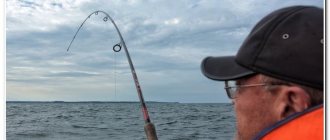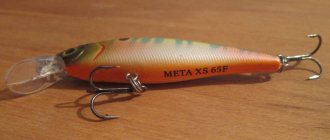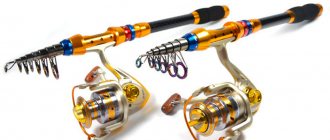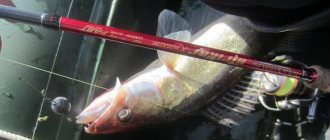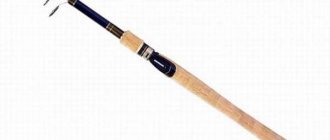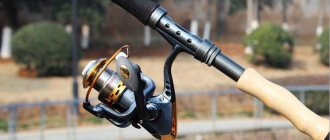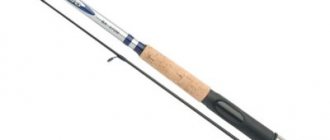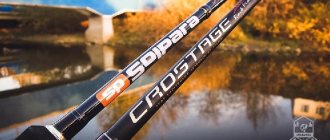Kosadaka spinning rods
Kosadak spinning rods come in plug and telescopic types. Both of these types are very popular among fishermen because they are very effective and easy to use.
The variety of Kosadak spinning rods is quite large. There are:
- light spinning rods;
- heavy (designed for jigging and trolling for especially large prey).
When buying a fishing rod from the Kosadaka company, a fisherman will not go wrong, since such tackle will make fishing as simple and enjoyable as possible. In addition, such fishing rods are made of high-quality materials, so the fisherman can be sure that they will serve him for many years.
TOP spinning rods for twitching
Norstream Dynamic F1
Nordstream spinning rods for twitching are the most famous because this brand is exemplary. They make the best fishing rods. And Norstream Dynamic F1 is the best representative of this class.

This is a whole series of 10 models that have different tests and lengths, but they all have one thing in common - they are configured for twitch fishing and are ideal for it. The one-piece handle is made of EVA, and the reel seat here is Fuji VSS+KSKSS. As for the rings, the proven Kigan Zirconia is used here.
Favorite Exclusive Twitch Special
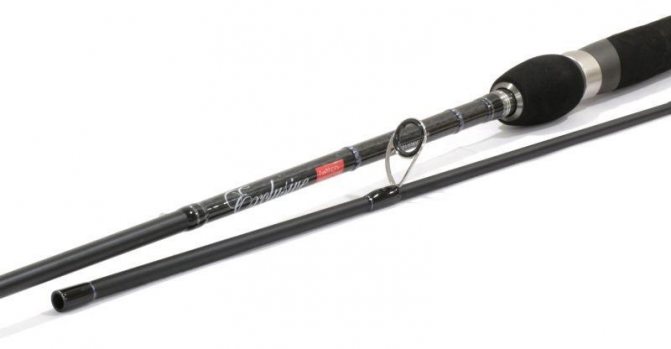
These fishing rods occupy the golden mean in terms of price/quality ratio. Presented in five models, all of which are intended for twitching only. Used for fishing minnows, the weight of which is 5-25 g. A fast action is used here, which has good rigidity and low inertia. Thanks to this, the fishing rod can perform different retrieves. The handle is one-piece, shortened, made of EVA. The reel seat is used by Fuji VSS, which has proven its convenience and reliability. You can also buy a model with a multiplier reel.
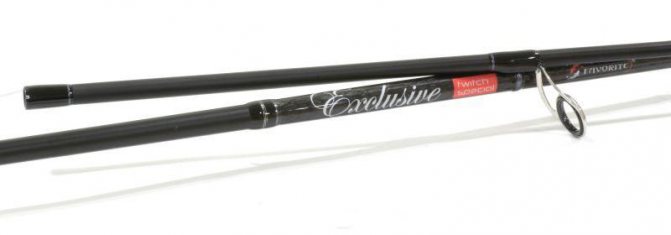
Black Hole Bassmania

This is another mid-priced twitching rod. That is why it is on the list of the most popular. You can note in it a spaced, shortened handle made of neoprene, which is pleasant to hold. The fishing rod is as lightweight as possible, as it is made of modern materials. It is used together with medium-sized wobblers.
Major Craft Rizer
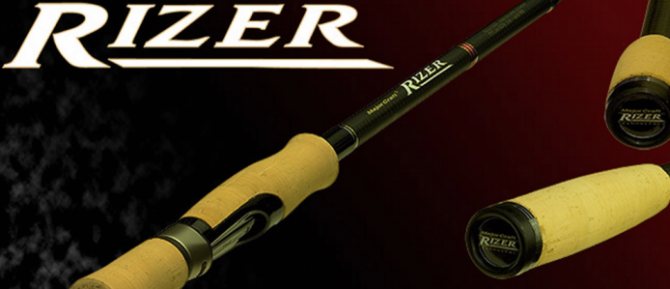
This series of spinning rods is already considered expensive, however, the demand for it among fishermen using twitch fishing is quite high. One of the advantages of this series is the ability to use it for jig fishing. These rods are also used when fishing with spaced rigs. If you look at other fishing rods at this price, the Major Craft Rizer is an order of magnitude better than them. A fast action is used here. The spinning handle is made of cork and is of a spaced type. The fishing rods have good sensitivity, minimal weight, high strength and power.
St.Croix Legend Elite

This spinning rod has universal tasks, but is more equipped for twitching. So, here the length is 2.13 m, which is typical for spinning rods with jerk wiring. Rod test - 5-17 g. The spinning rod is designed specifically for medium-sized minnows; in addition, it can be used together with crankbaits, spinners, spinners, and jig baits. This spinning rod is an ideal solution for those who want to fish not only with minnow wobblers, but also with other lures.
You may be interested in: Spinning Salmo Elite MicroJig
Norstream Provokator New

This spinning rod is an ideal ultralight fishing rod for twitching. Nordstream always makes perfect rods in all directions. This rod is designed to be used with small minnows weighing 7-8 g and measuring 5-7 cm, no more. The handle is spaced apart, made of EVA.
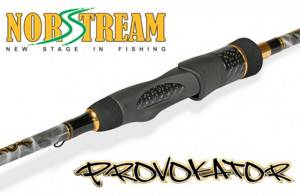
Along with it comes an anatomically shaped Fuji TVS reel seat and Fuji SiC Titanium anti-twist guides. The fishing rod belongs to the elite class, so it is purchased by professionals and amateurs who can afford such an expensive tool.
Rod designs
Kosadaka spinning rods based on fishing rod design are as follows:
- Simple (made from a simple undivided rod);
- Complex (have several collapsible elements and particles).
Collapsible fishing rods, which are much easier to transport, are considered more convenient than multi-meter rods that cannot be folded out.
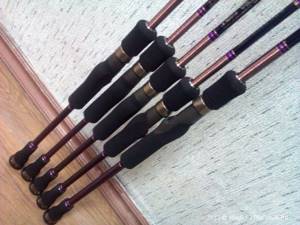
In this regard, the Kosadaka company in most cases produces folding spinning rods, which may be difficult to assemble, but, nevertheless, they are practical and take up very little space.
Such actions of the company elevate it above other brands, because spinning rods when disassembled become more transportable, and are also very long when unfolded, which allows the fisherman to fish over enormous distances.
Kosadak spinning rods have the following design features:
- Just like in other fishing rods, the elements in the rods of Kosadaka spinning rods that can be adjusted are called elbows. Depending on the type of knees, such spinning rods come in several types. Telescopic fishing rods, which are made only from very high-quality carbon fiber, are considered the most effective and convenient.
- Kosadaka pole rods tend to be very heavy and because of this they are not as popular as telescopic rods.
- The general design, all of the bends of which easily fit into the previous ones, as well as the generalized dimensions of the forms, which have a folded appearance, are classified according to the main dimensions of the first bend.
- Kosadaka folding spinning rods are considered not only practical for transportation, but also very convenient to store at home.
- All models of Kosadaka telescopic fishing rods can be folded to a size of half a meter, which is their big advantage.
- Telescopic low-knee fishing rods are more suitable for professional fishing, while high-knee fishing rods are more suitable for fishing by amateur fishermen. Therefore, it will be quite difficult to catch big fish with Kosadaka multi-legged rods.
Review of the Kosadaka Orange Twiching Point spinning rod. Reviews from fishermen about the Kosadaka Orange Twitching spinning rod
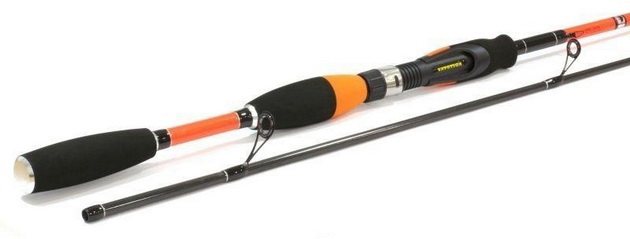
Kosadaka Quantum is a highly specialized line of spinning rods designed specifically for twitching minnow-class wobblers. The line consists of two spinning and two casting models united by one length - 2.13 m. This height was not chosen by chance, as it is excellent for fishing both from the shore and from a boat. The spinning rod is equipped with impressively sized rings, allowing you to fish with it in the cold without any problems, which will be especially appreciated by fans of winter spinning rods.
Spinning rods have a rapier-like action and a colossal power reserve. The length of the handle is short and made of spaced EVA. The windings of the upper rings are painted in a striking orange color.
Models with dough 5-21 g. Perfect for twitching any stubborn minnows up to size 110 and less stubborn ones up to 130 mm long wobblers.
Spinning rods with dough 7-28 g. such strong guys as Rudra, balisong, 128th pointer, etc. will be tough. The design of the spinning rod is discreet, but stylish.
Kosadaka Quantum SNT-213ML (2.13m 5-21g) Spinning rod weight 125 g.
Kosadaka Quantum SNT-213M (2.13m 7-28g) Spinning rod weight 136 g.
I happened to get acquainted with the Kosadaka Orange Twiching Point spinning rod quite by accident, and it happened due to the will of my friend. As they say, there would be no happiness, but misfortune helped. Literally! And it happened like this: in the middle of summer, a friend was ready to go fishing, with tents for a couple of days. It was absolutely impossible to refuse, I supported his idea completely and completely, and now on Friday evening I am getting ready, putting everything I need in the trunk, looking forward to an early departure on the water. But then that same friend calls me and sadly informs me that he has nothing to fish with: he literally just broke his spinning rod.
I went out to our local micro-river to leave the lures for half an hour, got caught on some snags, and with too sharp a jerk the tip broke in half. So the early Saturday departure is cancelled, since now he needs to find and buy at least some more or less normal fishing rod. This task was further complicated by the fact that this sad event came as a surprise not only to him, but also to the family budget, and therefore the amount for a new spinning rod could be allocated more than modestly. Okay, there’s nothing to do - instead of watching the sunrise on the water, we meet it in the city, and then go shopping in search of a new fishing rod.
We wander from storefront to storefront for a couple of hours, my friend tries out different models, shakes them, weighs them in his hand, looks at the price tags - in a word, trying to do the impossible, in my opinion - to find a good wand for ridiculous money. Meanwhile, gritting my teeth, I wander sadly at his heels, watching in agony as the morning hours flow by and realizing to myself that: a) it’s not bad now to at least be in time for the evening release of the pike, b) he set a task that is practically unsolvable, since the budget allotted to them includes only rootless Chinese with indistinct noodle-like systems and crooked forms, c) apparently, we will have to lend him money to increase the range of models under consideration and put an end to this torture.
And as soon as I opened my mouth to voice the last thought, suddenly my friend joyfully shouted to me from the rack with spinning rods: “Come here! Look what I found!” He found, as you may have guessed, Kosadaka Orange Twiching Point. And I looked. And having looked, I shared my friend’s reaction. And subsequently (of course, he immediately bought this spinning rod) I looked at it dozens more times, looked at it, tested it on fishing trips, caught fish with it, carried snags and nets, showed it to my friends and acquaintances, even conducted a spontaneous social survey. All this will be discussed in more detail below, but the main thing is this: Orange Twiching Point surprised me and all those who got its hands on it with its qualities. And it still never ceases to amaze me how (???!!!) Kosadaka managed to squeeze all the advantages of this rod into its price, equal to the price of any one Japanese wobbler. Spinning for the price of a wobbler... Amazing!
For those who are not yet able to see this model with their own eyes, I will tell you about it in as much detail as possible. We will talk about a spinning rod marked Kosadaka Orange Twiching Point 225ML, height 2.25 m, weight 135 grams, with a bait test of 5-25 grams. This is, in general terms, an ideal representative of medium-light spinning rods... I am sure that this model will be in great demand among Russian fishermen.
I’ll start with what instantly catches the eye of literally everyone when looking at Kosadaka Orange Twiching Point – its color. Thanks to this orange color, someone calls the spinning rod “orange”, but my friend immediately dubbed it “red” :). And this nickname stuck forever: as soon as he said to me something like: “Remember how I dragged that pike with a red cap?”, the image of Orange Twiching Point immediately appears in my memory. Kosadaki turned out to be such a powerful psychological marker, I don’t know whether it was intentional or not. Be that as it may, the model sticks in the memory very firmly, including due to its color – a combination of black and bright orange.
So, festive orange. It is present not only on the butt, but also on the last third of the whip. And if the coloring of the butt part is, rather, a tribute to design, then painting the whip in a bright color also has a useful function: at dusk, or in cloudy weather, and simply against the background of dark water, the tip is visible very well, you don’t have to strain your eyes to follow its movements when fishing with a jig, for example. And, perhaps, the brightness of the spinning rod’s colors is the main design decision in the design of this model.
Well, yes, there are inscriptions on the forms, the model name is printed in green and stylized as graffiti, but, again, what catches the eye is not the inscriptions, but the color design as a whole. As for the inscriptions on the blank, they are neatly applied; there is the name of the model, the characteristics of a particular rod, and even markings informing the buyer that “the blanks are designed for twitch fishing” and promising us “ultra-sensitivity and extra-fast action.” Thus, there are no complaints about the design of the spinning rod. True, I am a fan of more ascetic color schemes, but in the case of Orange Twiching Point, the proverb that “there are no comrades according to taste and color” fits perfectly.
Well, since I’m talking about forms, I can’t help but note the very pleasant fact for me personally that “Ryzhik” has a hookkeeper. It depends on everyone, but for me this is always a necessary option, but much more expensive models are often deprived of it. It just so happened that from my very first spinning rods I got used to the comfort that a hookkeeper provides when changing fishing spots, and I’m not going to get out of the habit of it.
And one more thing: the Orange Twiching Point has a hookkeeper located very well, not too close to the front of the handle, and this is excellent - the finger, lying on the blank, does not hit the hookkeeper, which means it does not experience any discomfort during any manipulations with the rod. Learn, manufacturers of spinning rods for 10+ thousand rubles! The blanks are made of carbon, and this choice of material does not raise any questions. Is it possible to complain that I couldn’t find the name of the manufacturer of the carbon itself, but that’s just me, minor quibbles.
Let's take a look at the rings now. What if something is wrong with them? The price is ridiculous, there must be a catch somewhere! Let's look. We look and see: the rings are installed perfectly, in a perfectly straight line, there are no deviations. The legs of the rings are securely fastened; I could not find any defects in the winding or varnish in the places where the rings were attached, nor were there any cracks in the coating.
Maybe inserting rings spells trouble for us? But no, although the rings do not have the Fuji inscription, the inserts in them are made of silicon carbide (SIC), and the same material is used in the manufacture of rings for a huge number of other models of spinning rods, since it is considered one of the best in terms of price/quality ratio. SIC is popular due to its high strength, resistance to mechanical and abrasive influences. It is also worth paying attention to the fact that the tulip is “dressed” in an anti-whip frame, which is rarely found on ultra-budget spinning rods from other manufacturers, when the quality of the rod parts is sacrificed to a low price. Kosadak has a different approach: the price is low, but the equipment is equipped with all sorts of amenities and attention to detail - almost like “adult” models. The sizes of the rings allow you to use spinning rods in winter.
Let's move on to the handle. It, like most modern models with twitching specialization, is spaced. This is an absolute plus, since this type of handle simplifies the manipulation of the rod, makes the animation of lures more comfortable - the weight of the handle is reduced, and thanks to its size, it does not cling to clothing. All elements of the handle are made of EVA, and here again Kosadaka is in trend: EVA gets dirty less, is less cold on the hands, does not chip, and is easy to clean.
Metal elements are present, but in minimal quantities - literally a few rings, so there is no need to worry about your hands getting cold. The reel seat here is not Fuji, but some kind of our own, with Kosadaka markings. It is screw-type, the nut is located at the bottom. I have never had any complaints about the quality of the holder, the plastic is durable, the reel stays tightly in place, and I have never encountered any spontaneous loosening of the nut. The rear position of the nut does not cause any complaints, since when gripping the hand practically does not come into contact with the nut, which means there is no accidental impact on it.
And one more pleasant nuance associated with the handle. Pay attention to the metal part covering the lower end of the handle. In my opinion, this is a very smart decision. Many spinning rods have either the manufacturer’s logo in this place or a recess in the handle into which the logo is recessed. And with the active use of a spinning rod, this place is constantly exposed to impact: we rest the spinning rod with the end of the handle either on the shore or on the floor of the boat - as a result, the end gets wet, dirty, scratched, logos and stickers fly off, the recesses become clogged with dirt, and so on. This does not happen here, since the end is covered with a metal plate. Comfortable? Certainly!
And I would like to say a few words about the build quality. Hand on heart, I was afraid that the assembly would turn out to be so-so... And I was wrong. Nothing creaks anywhere, does not play, does not fall off or come unglued. The only thing I could find fault with was the processing of the end of the whip at the plug connection. The photo shows that it (the end) is not processed very carefully, there are some irregularities. But I will immediately praise the thickness of the walls of the whip at the junction - I wouldn’t call them flimsy, they look quite reliable. However, situations are different, someone (like my friend) periodically manages to break their fishing rods, and with a “saffron milk cap” this is not a big deal.
Because the whips can be purchased separately, their price is ridiculous, less than 1000 rubles, that is, roughly speaking, less than half the cost of a spinning rod. And this is excellent, because I personally am annoyed by the irrepressible passion of some manufacturers for our money, when it is either impossible to find in stock (and even order!) a whip, or it turns out to be unreasonably expensive - they say, buy a new spinning rod entirely. Fortunately, Kosadaka does not practice such an inhumane approach.
Spinning rods of the Orange Twiching Point series are equipped with covers. They are quite simple, but quite suitable for transporting a fishing rod in a car. The case has only one compartment, the case itself has laces, but given the price category of the model, it makes no sense to make any increased demands on the case, thanks for the fact that it exists at all. The case is bright in color, the characteristics of the spinning rod are marked, everything is perfectly legible.
I used this stick several times in conjunction with a Shimano Nasci 16 2500 reel (weight 250 grams), but more often - together with the same reel that a friend uses - Kosadaka Roger 2500F (weight 297 grams). So, in neither case did any problems arise with the balance of the tackle. In conjunction with Roger, the balance point is exactly at the level of the coil bow. And despite the fact that the total weight of the set exceeds 400 grams, the hand did not get tired even during long fishing trips.
And now that the spinning rod has been carefully examined, it’s time to talk about what it’s like in action. We remember that the manufacturer promised us extra-fast action. But one can argue with this; Kosadak also has models with faster action, with real extrafest. The “Ryzhik” has a system close to the usual fast one. But this is more than enough, the spinning rod is quite rigid when shaking, it can only be swung with a good effort, the movement of the tip is clear, without swinging to the sides.
The structure is fully enough for a confident hooking, and for practicing all the movements of the fish when playing, the predator “fits in” perfectly, the “orange” manages to react to any jerks and tricks. Everything is fine with casting plastic baits: due to their length and structure, they fly away confidently and at decent distances, wobblers weighing from 8 grams are already quite throwable at 30-35 meters. Anything heavier flies even further and more confidently, with a clear feeling of the blank being turned on at the moment of casting. By the way, the weight of the bait reaching the upper limit of the test (25 grams) does not mean at all that you cannot throw anything heavier.
It seems that there is plenty of safety margin in the stick, since even 30 gram spoons are thrown easily and without any fear for the health of the whip. Thus, I would indicate a comfortable and confident test for baits at 8-30 grams instead of 5-25. I also had no concerns about the strength of the rod; one-kilogram pikes don’t even load the blank; it starts working from about one and a half kilogram specimens, so the fight with the trophy will probably end in victory for the angler, and not in the breakdown of the spinning rod. Powerful fighting is something that “orange” can handle easily, without straining.
As for the animation of baits, that very twitching that appears in the name of the model, then this is in complete order. Almost any model of wobblers whose weights fall within the test range performs excellently. Generally speaking, the animation of the vast majority of wobblers with sizes of 60-65mm does not raise any questions; much more often, anglers are interested in how this or that spinning rod pulls large and heavy baits with sizes of 110-130mm. Orange Twiching Point easily copes with such “heavyweights” as, for example, OSP Rudra F/SP, Deps Balisong 110, Strike Pro Inquisitor F/SP, TsuYoki Rudra 130, Kosadaka Flash 130F.
You can list many other wobblers, but, according to my observations, if a spinning rod is able to cope with the baits listed above, then no difficulties will arise with the animation of similar weights/persistence/sizes. Thanks to the structure of the rod and the rigidity of the whip, the tip does not fall through even with fairly strong jerks. I think there is no need to dwell separately on wobblers measuring 80-110 mm and weighing 10-20 grams, since it is clear that for the “saffron milk cap” these are just the ideal baits; their animation does not cause any difficulties at all. So the spinning rod received the phrase Twiching Point in its name completely deservedly.
And at the same time, “orange” is quite suitable for jigging. You can’t call it a general all-rounder in the sense that a spinning rod will be able to provide the same sensations that jig rods provide, however, if circumstances force it, it is quite possible to switch to jig fishing. According to my feelings, comfortable weights start at about 10 grams, at 12 you already get clear tactile sensations.
If we talk about working with spinners, then everything is very clear here: with spinners up to 30 grams, “orange” works easily, the casting range is excellent, and the readability of spinner movements starts from 10 grams. There are also no surprises with spinners: from number 2 according to Mepps it’s normal, from number 3 and above – excellent, they throw confidently, the moment the blade is turned on is felt both tactilely and visually along the tip.
Of course, everyone is concerned about the issue of sensory, and therefore it would be unfair to ignore it. In addition, “ultra sensitive” is emblazoned on the form. And this moment is very ambiguous. I'll try to explain why. For example, my friend who bought this spinning rod was delighted with the “sense”. I deliberately interrogated him with passion after the first trip, when in the evening we sat with him by the fire and discussed the past day. According to him, he felt every touch of the bait on algae and driftwood branches, and confidently distinguished them from bites; the sensory capabilities of the “saffron milk cap” were impressive, considering that the sensations from the spinning rod he had broken the night before were still fresh in his memory. My father had almost the same opinion about Kosadaka Orange Twiching Point, after fishing there for several hours in a row.
Later, I begged a friend for a spinning rod several more times and gave it to my fishing partners in order to hear their feedback on the sensitivity of the rod. And, of course, I caught it myself. Everyone praised the sensory skills; there were no exceptions. And this is one side of the coin. And the other is that personally, “orange” seemed dull to me. But the reason for my perception is simple and extremely subjective: when you suddenly switch from one spinning rod to another, and at the same time the price categories of these two spinning rods differ tenfold, naturally the sensory will be different. But if you fish with “orange” without holding top models in your hands until now and without previously getting used to their sensitivity, then yes, its “feeling” is impressive.
Unfortunately, the review format unwittingly introduces an element of bias into the reader’s perception of any thing, since the reader knows in advance how much money the item being described costs. And subconsciously, the assessment of the properties of the item is adjusted to the specified price. Well, you know those stereotypes: “The more expensive the better” or “Good things cannot cost little”? It is much more interesting to observe people's reactions by putting an object in their hands, allowing them to examine and try it, and then asking how much they think the object is worth.
Naturally, without disclosing the price. I conducted the same survey among about a dozen of my friends, partners, and fishermen I just met on the shore. In a word, among people who are directly related to spinning fishing. And guess what? None of the respondents could guess the price! Not a single person suggested that this spinning rod costs about one and a half thousand rubles. The minimum estimate was 2,800 rubles, the maximum was 5,000. Imagine their surprise when I announced the true price. People simply refused to believe!
That is why, as well as in terms of the totality of performance properties, reliability, built-in safety margin, quality of workmanship, sensitivity and structure, I consider the Kosadaka Orange Twiching Point to be a rare phenomenon on the gear market. In my opinion, this is a landmark product in its own way, thanks to which Kosadaka not only got ahead of its competitors, but completely outdid them. What can I say? Only - bravo!
I won’t bore you with a long introduction, but will go straight to the point: for quite a long time I’ve been looking for a normal budget spinning rod, from which I don’t need to “wipe off specks of dust,” but which can fully and completely endure the hardships of a winter spinning rod. At the moment, three rods from the Kosadaka company have passed through my hands, and they all had a very significant advantage: each model had amazing sensitivity, which, you see, is quite important in any type of fishing. Design? An undeniably important point of purchase, but the main thing for spinning fishing from the shore in winter is the diameter of the guide rings. And that’s why, having added up all the factors I need, today I want to tell you about a spinning rod from the Kosadaka company - Orange Twiching Point in the SONG225ML version.
Case. Here the company, as usual, pleases with color - the case is so bright that even in the snow it will simply be impossible to forget it while fishing. As for the rest, there is not and will not be anything incredible and essentially unnecessary. Don’t forget how much a spinning rod costs - there is only one compartment and not divided. Whether it is good or bad is up to you to decide! As for me, with proper handling and care during transportation, any spinning rod can serve you faithfully for a long time. And “out of the blue”, and you yourself know what can be broken.
Spinning. The rod certainly looks more than worthy! The well-crafted design literally makes you pick it up and shake it when you see it in the store. In my case, it was enough to see “on the shelf in an online store”, and the desire to purchase appeared immediately! The first thing that caught my eye when it was in my hands was the diameter of the throughput rings. The thing is that many manufacturers, following the path of lightening the weight, put rather small rings on spinning rods, and it is now quite difficult for a winter spinning player to find a tool with a completely opposite option. Here is the same case that certainly needs to be listed as a huge plus. “SIC” inserts are quite popular and practical - there will definitely be no problems with the cord. No defects were found on the rings: no varnish smudges, winding - everything is at the highest level, which I actually had no doubt about.
The blank of the rod, from the beginning to the very tip, is a series of orange and black colors. The reel seat is made of soft and practical Eva material, with a lower allowance nut, and is also painted in a series of colors of the spinning rod, which certainly once again emphasizes the design. There is an important detail for me - the presence of a “hook-keeper”, which many manufacturers have begun to forget about, cannot but rejoice, since the average spinning player moves quite a lot, and I don’t really want to hook the hook of the spinner to the rings once again . Weight is 135 grams, with a transport length of 118 centimeters - to be honest, I didn’t check this, taking my word for it, by the way, Orange seemed rather lame to me, since I expected to see a completely standard “peg”, which many people use for twitching wobblers, and we will dwell on this issue separately, but a little later.
First meeting. Even though the spinning rod was purchased for winter fishing, it would be a crime not to try it in the summer! Fishing, by the way, that day turned out to be frankly disastrous, but I still managed to make the main discovery. With a complete lack of bite, I had to install a “diverter leash” equipment, at least for perch, and... The bite of a 10-20 gram robber, clearly and loudly knocked in my hand! Yes Yes! And this is in a rod for that amount! This means that in the cold cold, through winter gloves, there is a chance that even the most accurate bite of a wobbler will be tactilely felt - and this is exactly what I wanted!
Practice. The long-awaited, but still quite interesting, season of winter spinning has arrived. Each fishing trip alternated a huge experience, with an endless search for a catch, and the perfect recipe for catching a predator, thereby getting me closer and closer to my new winter tool - Orange Twiching Point. And it must be said right away that, despite all the visual laziness, the spinning rod is perfectly suited for fishing with wobblers. In addition, surprisingly, in this type of fishing with certain baits, the test on the form is announced very correctly! The wobbler, weighing just over 5 grams, flew away to the maximum of its capabilities, and was controlled quite correctly by the rod; when a jig weighing 24 grams plus bait was given with obvious failure. As a result, through trials and experiments, I came to the conclusion that the test fully corresponds to what was stated, and this is a clear plus for the manufacturer.
Conclusions. In conclusion, when the winter spinning season has almost come to an end, we can safely sum up the results of our acquaintance with the fishing rod. If I summarize everything written above, I can only draw one conclusion - you need to take it! When, for such a small price, it is possible to get a very workhorse, in such a difficult and difficult type of fishing from the shore, with all its correctly indicated characteristics, and excellent design - to be honest, I just don’t know anything similar from competing companies. And, I repeat, for its price, there is very excellent tactility, the sending of the bait, and, moreover, ringing sensory. Well, is it possible to resist?
Good day everyone, dear ones. Have you ever had the feeling that some thing can lift your spirits simply by its presence? This is exactly the feeling I now experience after purchasing the Kosadaka Orange Twiching Point spinning rod. The name itself seems to hint at the color and specifics of this gear, but let’s take it in order.
As they say, “they meet you by their clothes” and Orange Twiching Point has no problems with this. A bright fabric case in the color of a juicy orange and printed inscriptions even before you take the spinning rod in your hands puts you in a positive mood. Of course, I would like to see “Velcro” on it rather than “strings”, but do not forget about the price niche of this product.
The first thing that catches your eye after assembling the “stick” is the rather unusual shape of the handle, which I called “float”, and the bright, cheerful style in which the entire spinning rod is made. The predominant colors are orange and black, which play well in contrast, and their combination evokes the feeling of owning far from budget gear.
The form contains high-quality inscriptions that inform us about the test and structure of the spinning rod, as well as nice graffiti in which we can see the very name of the gear. The model range is quite extensive both in length and in tests and includes the following modifications, allowing you to make a choice specifically for your needs. Length/test/weight 2.10/3-17/114 2.25/3-17/129 2.25/5-25/135 2.4/10-35/151 2.4/3-17/138 2.4/5-25/147 2.7/10 -35/188 2.7/5-25/168
As you can see, it is possible to choose a model for using both spinners and wobblers, and a medium jig. Fishing by jigging is also hinted at by the bright tip of the spinning rod, thanks to which we can more easily control the retrieve and bites of the “nibblers”.
I got my hands on a “stick” in size 2.25/3-17, so all the information will be about this, I would say, station wagon. The blank is made of high-molecular carbon, which allows you to get a fairly “fast” rod with low weight. The form's action is stated as Extra Fast, but I have the impression that it is closer to simple Fast. Despite this, the spinning rod quite normally twitches a wobbler up to a hundredth size, and smaller wobblers or “hardware” do not cause the slightest problem for it
The spaced float handle is made of modern EVA material and has some features of an anatomical shape. When choosing the right reel, it allows you to animate baits for a long time without any fatigue to the fisherman’s hand. Also, in the cold season, the material of the handle has a positive effect on a person’s tactile sensations.
Ceramic fittings, despite the rather high “legs” in my opinion, are made of high-quality silicon carbide “SIC” and will not cause problems when using braided cords or wood. If abrasive particles get on the cord, the material of the rings, according to the manufacturer, will not undergo so-called “cuts” for a long time.
The spinning rod is equipped with a folding hook holder with the fashionable name “Hook Keeper”, which is good news especially when moving to a new fishing spot, when disassembling the spinning rod is impractical.
The varnish coating of the blank, as well as the filling of the places where the rings are attached to the spinning rod, is quite smooth, but is not without some inhomogeneities over the entire area, which becomes noticeable upon careful inspection.
The spinning rod is equipped with a screw reel seat with a lower fastening ring, which is currently one of the most reliable solutions. The fastening itself is made of high-quality polymers, thanks to which there is no doubt about the reliability of the unit.
The plug fastening of the knees is made at a decent level, the walls are uniform. In the future, I would like to see Kosadaka have two points on the form for aligning the knees, but this is rather nit-picking.
Now a few words about the operation of the spinning rod. The test I chose does not seem to imply the purposeful catching of trophy predators. The average size of a pike for this stick is approximately two kilograms. And when playing a toothy fish of approximately this size, the full potential of the spinning rod is revealed. Thanks to the elastic blank, the fight usually ends in favor of the angler. Even during candles, which small pike “sin” with, the spinning rod perfectly “knits” the prey and gives no chance of escape. It was from Kosadaka Orange Twiching Point that I began to feel the joy of perch fishing. With uniform wiring, even the rotation of the petal is transmitted to the hand, not to mention the resistance of the perch. The split strikes of the striped robber delight the angler and give him a feeling of slight euphoria.
Despite the rather short length of my “stick,” casting even small spinners or trout spoons is very comfortable. At the same time, it seems that the spinning rod throws on its own.
Of course, the main focus of this gear is twitching. There are no problems with this at all. Despite its price, the blank copes well with wobblers up to 110 mm in size inclusive, but I would still call the optimal size for this test a wobbler size of 70-100 mm and weighing up to 15 grams. If you don’t experience any problems when casting large wobblers, but when animating large baits, the form begins to “sag.” In connection with this, it is necessary to make more sweeping “blows”. Don’t forget that my spinning rod has a small test and there are more powerful “sticks” in the line that can easily cope with large baits. In conclusion, I want to say that, despite some shortcomings and slight lies from the manufacturer about the structure of the spinning rod, we have a very good form for a more than humane price.
Read other articles, reviews and testimonials:
- Review of the Graphiteleader Vigore spinning rod. Reviews from fishermen about the spinning rod Graphiteleader Vigor
- How can you catch pike perch? Where to look? Basic methods of catching pike perch
- Review of the Maximus Manic spinning rod. Reviews from fishermen about the Maximus Manik spinning rod
- How to cast a spinning rod against the wind? Casting technique against the wind.
- Review of Graphiteleader Bellezza and Bellezza Correntia spinning rods. Reviews from fishermen about the spinning rod Graphiteleader Beleza
Basic parameters of spinning rods
The main parameters of Kosadaka spinning rods include:
- length;
- material;
- power.
Length
The length of the spinning rods is a very important selection criterion. The Kosadaka company produces spinning rods with lengths that vary from 1.5 meters to 2.6 meters.
In addition, a separate line of Kosadaka MUSTANG Light Special spinning rod models is also produced, the length of which is 2.80 meters.
Material
Kosadaka spinning rods are made from high-quality carbon fiber using modern technologies that are used to create a wide variety of fishing gear.
In addition, it must be said that products made from this material are considered very popular and sold.
Power
Kosadak spinning rods are designed for casting light baits, so you should not overload them with too heavy baits.
But the overall power and performance of the spinning rod is at a high level. As an example, we can cite the lightest rod for salmon fishing – the Kosadaka three-arm spinning rod.
Tests of spinning rods for twitching
To select a spinning rod for a specific wobbler, you need to take into account the weight of this bait. So, when choosing a fishing rod, choose a top test that has a few grams of power reserve. After all, it is planned to use a spinning rod for a jerk bait, which means that it must be cast far and then animated with high quality. If the test of the rod is less than required, the jerks will be inconsistent and the bait will not be cast close. In some cases, when throwing, the rod may even break.
There is a classification of spinning rods for jerk fishing, depending on the type of test:
- ultralight - from 0 to 7 g.
- light - range 8-15 g.
- medium - within 15-25 g.
- heavy - over 25 g.
After analyzing the above criteria, you can choose a successful rod for jerk fishing. There is a huge selection of spinning rods for twitching. Some people prefer casting spinning rods for twitching, others don’t trust ratings and prefer to choose the product themselves. In certain circles, Aiko spinning rods for twitching are in great demand, in others - Nordstream. But there is still a generally accepted TOP, rods from which will clearly be a good choice.
You may be interested in: Spinning rod Graphiteleader Calzante
The best models from Kosadaka
Despite the large number of spinning rods from Kosadaka, the following models are considered the best and most popular:
- Kosadaka MUSTANG 240L;
- Kosadaka MUSTANG Light Special;
- Kosadaka Star Force;
- Kosadaka Absolut Bass Special;
- Kosadaka Arrow.
All these spinning rods combine reliability, quality and affordable cost, which makes them irreplaceable.
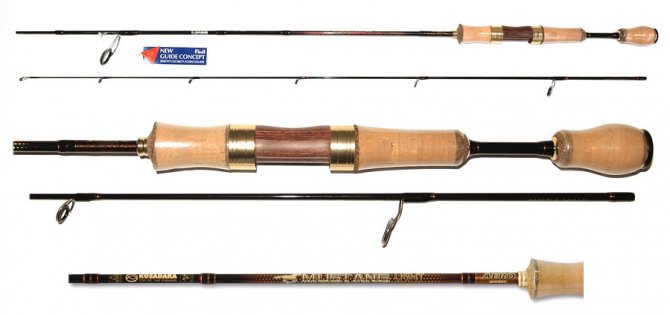
Kosadaka
The Kosadaka brand is a very young but dynamically developing brand that is just beginning to firmly enter the modern fishing goods market. In Japan, the homeland of Kosadaka, this brand already occupies a serious position in the market.
At the moment, under the modern Kosadaka brand, not only a wide range of modern spinning rods of high quality and different classes are produced, but also many related products, including wobblers, reels, fishing lines, baits and so on.
Is it worth buying?
Before purchasing such a spinning rod, experts recommend determining for yourself how often you will use this rod, what kind of fish you want to catch and in what bodies of water this will happen. Having solved all these questions, you will know exactly what you need.
If you are engaged in semi-professional or amateur fishing and want to purchase a reliable spinning rod that will work properly, then Kosadaka spinning rods will cope with this task perfectly.
In addition, such fishing rods have a sufficient number of advantages that make it indispensable in some aspects, so when purchasing them, you will not be dissatisfied with the purchase.
